Drought conditions continue to deteriorate across Puerto Rico and the US Virgin Islands. June and July are historically considered periods of lower rainfall, and therefore persistence and/or expansion of drought conditions remain the most likely scenario during June and July.
The onset of the traditional wet season in late July through November should result in drought improvement. With the drought being severe and long-term in nature, the importance of the wet season rains delivering as usual is extremely critical.
View this update in Spanish.
Key Points
- Puerto Rico Conditions: Drought conditions are now observed across most of Puerto Rico with impacts reported island-wide. An area of severe drought (D2) is now centered on the northeast part of the island. Rainfall from earlier this week may have helped improve dry conditions in some areas.
- U.S. Virgin Islands Conditions: Severe drought (D2) or worse now exists on all three islands, due to drier-than-normal precipitation, with the most serious conditions being reported in St. Croix, which is in extreme (D3) drought. By definition, D3 drought occurs every 20 to 50 years.
- Puerto Rico Impacts: Voluntary water-use restrictions have been requested across most of Puerto Rico. However, water-use restrictions have been imposed for sectors in Loiza, Canovanas, Rio Grande, Juncos, and Las Piedras. Dry pastures have led some ranchers to turn to hay and supplements to nourish cattle. A sharp increase in grass fires has been observed as well.
- U.S. Virgin Islands Impacts: The increasingly dry and windy conditions are reducing soil moisture and negatively impacting vegetation, with signs of distress across the territory. Ponds are not recharging. Livestock farmers and horse ranchers are buying hay and conserving water, with most cattle ranchers seeking feed support at this time. The VI Fire Service announced on Monday, June 13, that it has issued a ban on outdoor burning until further notice.
- Looking Ahead: Climatologically speaking, rainfall totals in June and July are usually less than in May, before the late summer ramp-up in August. As a result, a generally stable weather pattern usually prevails and continued drought is expected. Most shower activity during this time is usually focused across the western interior of Puerto Rico. Precipitation from August to November will be critical for breaking the drought.
- For weather information specific to your area, please monitor products issued by the National Weather Service in San Juan, Puerto Rico.
U.S. Drought Monitor map for Puerto Rico, as of June 14, 2022. The U.S. Drought Monitor is updated each Thursday to show the location and intensity of drought across the country.
U.S. Drought Monitor map for the U.S. Virgin Islands, as of June 14, 2022. The U.S. Drought Monitor is updated each Thursday to show the location and intensity of drought across the country.
U.S. Drought Monitor Categories
U.S. Drought Monitor map for Puerto Rico, as of June 14, 2022. The U.S. Drought Monitor is updated each Thursday to show the location and intensity of drought across the country.
U.S. Drought Monitor map for the U.S. Virgin Islands, as of June 14, 2022. The U.S. Drought Monitor is updated each Thursday to show the location and intensity of drought across the country.
Drought Conditions
-
Puerto Rico: Nearly 66% of Puerto Rico is under a moderate drought (D1) with severe drought (D2) conditions now observed across portions of eastern Puerto Rico. D1 conditions continue to be focused across the south-central, the interior, and the northern slopes of the island.
-
U.S. Virgin Islands: Extreme (D3) drought conditions are still observed across Saint Croix with severe drought (D2) noted across Saint Thomas and Saint John.
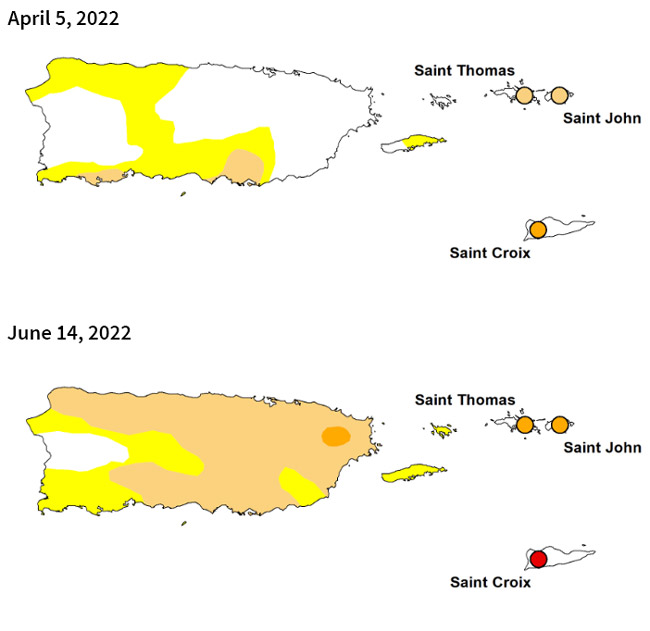
Sector Impacts
General Conditions
- Puerto Rico: Rains earlier this week may have helped to alleviate dry conditions in certain areas. Prior to the rains, conditions in Puerto Rico had become increasingly dry in recent weeks. The majority of the territory is being affected by abnormally dry or moderate drought conditions. Low soil moisture in some areas is causing cracks to appear in the soil. Some vegetation is browning and showing signs of stress. The southwest region of Puerto Rico is reportedly dry, with particularly low soil moisture in Lajas and Mayaguez.
- U.S. Virgin Islands: All major islands in the USVI are receiving light intermittent rain and the year is drier than normal. Due to drought in 2020-21, more than five dozen livestock farmers across the USVI qualified for monetary assistance through USDA's Livestock Forage Disaster Program (LFP). With drought continuing or intensifying in 2022, many of the same producers will again be eligible for LFP support. Horse ranchers and livestock farmers are continuing to conserve water and purchase hay. Ponds are dry and collection containers are not filling up.
Agricultural Conditions
- Puerto Rico: Dry conditions in some areas have reduced soil moisture and caused crop stress in some agricultural operations. Water levels of retention ponds have reduced due to prolonged dryness. Dry conditions have also led some farmers to increase irrigation hours to compensate for dry conditions.
- St. Thomas: Poultry farmers indicated that they are purchasing water for watering chickens due to a lack of rain and recharge in their cisterns, and that increased heat is impacting egg production. Farmers are also reporting windy weather which contributes to a lack of soil moisture. A private, agricultural pond in St. Thomas has not been filled completely since 2015, due to a lack of substantial rain. Specialty and row crop farmers are reporting that greens, including lemon grass, kale, and peppers, are burning due to heat and wind, and orchards that require more water are still only being watered every other day. Most are employing conservation methods including the use of drip irrigation and working to increase the storage capacity of water and irrigation methods. A linked video taken on June 11, 2022, shows the current conditions of drought on Water Island near St Thomas. (Note: Sahara dust which can be seen in this video is impacting the rooftop water collection.)
- St. John: Farmers are reporting that they are watering both early and late to retain soil health and are conserving water. Soil cracking has become more apparent as temperatures and winds increase. Farmers are also implementing conservation methods including alternating watering schedules to maximize water resources. Farmers indicated the need for increased irrigation and Smart Technology that will help them to combat drought. Orchards are dry, rainwater is sparse and high winds are impacting production.
- St. Croix: Farmers who have been purchasing water are concerned due to the high economic impacts of costs related to water. Farming operations of all sizes are reporting that hot, dry weather is still affecting their ability to retain soil moisture. Farmers are reporting increased impact due to the financial burden of water and feed due to severe drought. For example, one producer reported purchasing 16,000 up from 12,000 gallons of water per week. Long-term drought indicators are creating an urgent need for drip irrigation systems to be deployed in the fields. Poultry farmers are reporting increased purchases for water in cisterns and reporting decreased egg production due to heat. The VI Department of Agriculture (VIDA) reported that, on St. Croix, water deliveries to the agricultural community were up to 1,187,330 gallons of water in April and more than 1,134,170 gallons in May. However, access to the VIDA water delivery services and community garden use have been impacted by power outages that intermittently stops the pumping. VIDA also reported that both horse and livestock ranchers are procuring hay at this time. Some of the farmers are collaborating with local brewers to access spent grain to use as feed to supplement a lack of access to hay.
Rainfall Deficits
- Puerto Rico: 90-day rainfall deficits of 8 inches or more now cover most of northern Puerto Rico. From April 1 to June 14, San Juan Luis Munoz Marin Airport reported only 4.27 inches of rainfall, or about 33% of normal. This is the driest such period since 1997, and the 5th driest on record since 1899. Most parts of the island have deficits of 4 to 8 inches. The highest rainfall deficits (up to 16 inches) are observed mainly across the central interior and northern slopes (Figure 2).
- U.S. Virgin Islands: The rolling 365 rainfall total at Henry Rohlsen Airport (ISX) in St. Croix of 23.73 inches is the driest such period on record there in 59 years of data. This is a deficit of over 13 inches. The recent short-term dryness has exacerbated the ongoing longer-term drought (Figure 3).
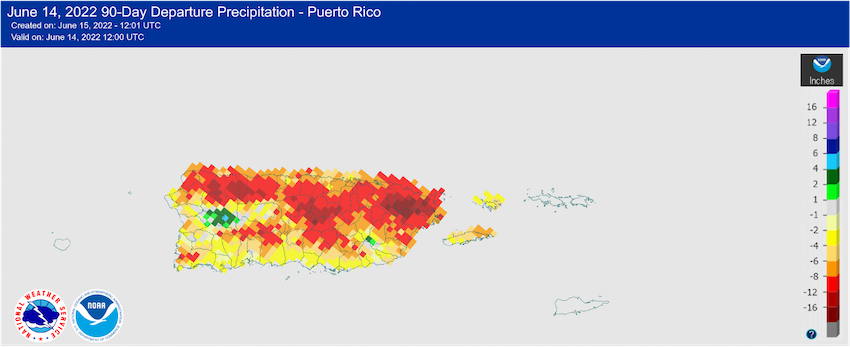
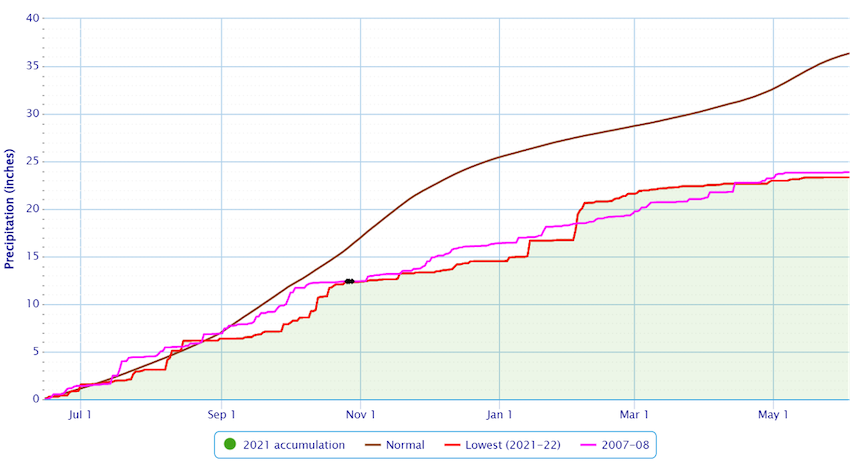
Soil Moisture Conditions in Puerto Rico
The latest soil moisture data from the Puerto Rico Agricultural Water Management (PRAGWATER) indicates dry soil conditions persisting across most of Puerto Rico (Figures 4 and 5).
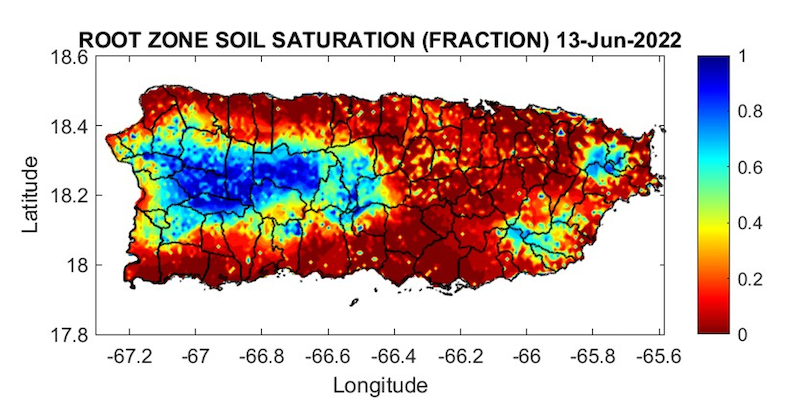
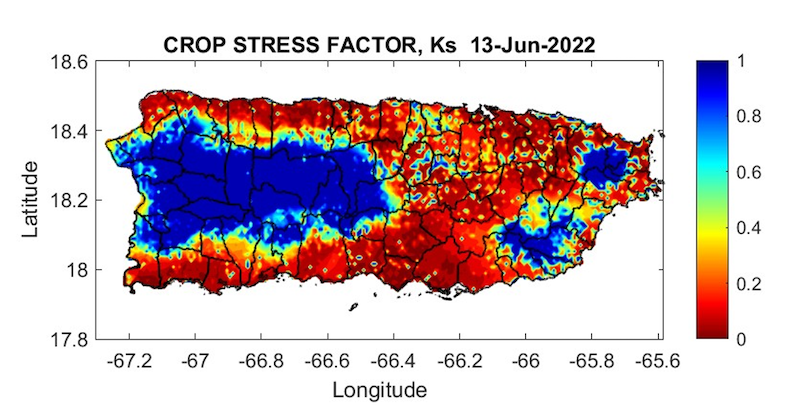
Streamflow and Reservoir Conditions in Puerto Rico
The 28-day average streamflow from the U.S. Geological Survey (USGS) river gauge network indicates most streamflows running below normal or well below normal across most of Puerto Rico (Figure 6). Reservoir levels continued to recede with Carraizo, La Plata, Carite, Guajataca, Toa Vaca, and Cerrillos under close observation. Adjustments during daily operations have been applied. Rainfall from earlier this week resulted in some improvements to important reservoirs, such as Carraizo.
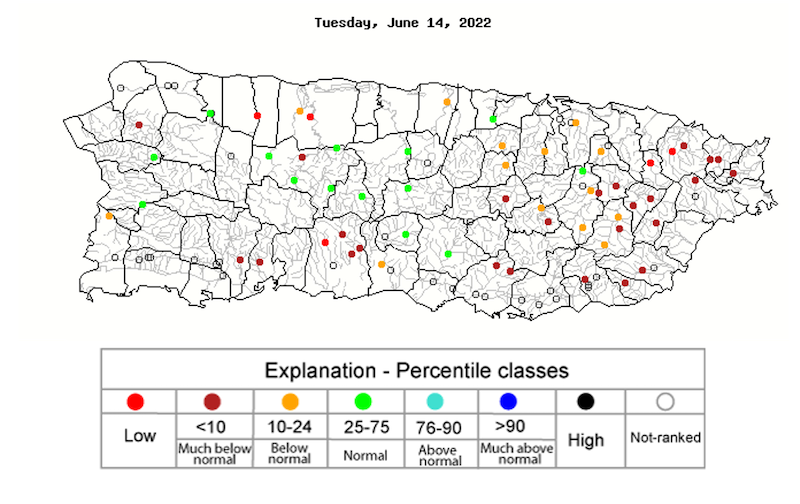
Groundwater Conditions
Well levels are below-normal to record low in south-central, southeastern, and north-central Puerto Rico. Across all the U.S. Virgin Islands, groundwater levels continued to recede (Figure 7).
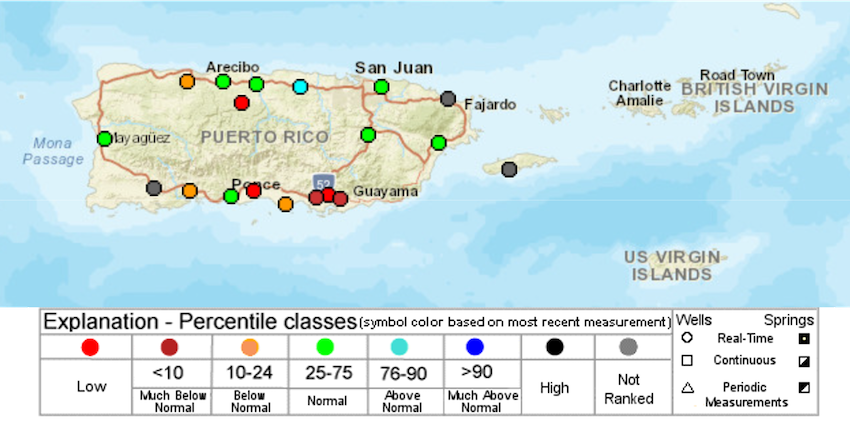
Outlooks and Impacts
Rainfall Outlook
- Climatologically speaking, May is one of the wetter months of the year, with June and most of July being somewhat drier. There is typically a significant increase in rainfall between August and November. The below figure shows the 30-year normal for monthly rainfall for Cyril King Airport in St. Thomas (Figure 8).
- Going forward, for drought improvement, it will be essential for Puerto Rico and the USVI to see at least normal rainfall during these 4 months of August to November. The CFSv2 seasonal precipitation forecast model for July-August-September shows a slight tilt towards wetter-than-usual conditions.
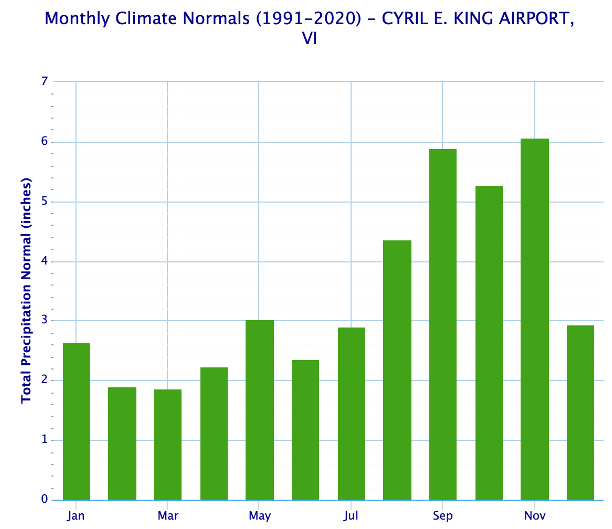
For More Information
- National Weather Service (NWS) Weather Forecast Office – San Juan: Climate and Drought Information
- NWS Drought Information Statements for Puerto Rico and the U.S. Caribbean
- Drought.gov:
- Caribbean Drought Bulletins. Caribbean Regional Climate Center, Caribbean Institute for Meteorology and Hydrology (CIMH), Barbados
- U.S. Department of Agriculture (USDA) Caribbean Climate Hub drought and disaster assistance resources for tropical forestry and agriculture
Prepared By
Odalys Martinez
NWS Weather Forecast Office – San Juan
Meredith Muth
NOAA/National Integrated Drought Information System (NIDIS)
Victor Murphy
National Weather Service Southern Region
Christina Chanes, Gregory Guannel
University of Virgin Islands
William Gould, Nora Álvarez-Berríos, Eva Holupchinski, and Luis Alexis Rodriguez Cruz
USDA Caribbean Climate Hub, USFS International Institute of Tropical Forestry
Brad Rippey
USDA Office of the Chief Economist
Héctor J. Jiménez
Office of Climatology, University of Puerto Rico
Puerto Rico Reporting Input: Thanks to the Agricultural Extension Service, College of Agricultural Sciences, University of Puerto Rico-Mayaguez. Special thanks to Eric Harmsen, Professor of Agricultural Engineering UPR-M; Agro. Alberto J. Maldonado Rodríguez; and Betzaida Ortiz, Agroempresas Atabey, Inc.
USVI Reporting Input: Several individuals contributed to this report and we are acknowledging the following for their support including the faculty, staff, and collaborators of the UVI Physics Program, UVI Etelman Observatory, UVI Agricultural Experiment Station, VI Department of Agriculture as well as the USDA Office Chief Economist, National Parks Service in St. Croix, USDA Farm Service Agency, Coral Bay Community Council and the many field staff, volunteers, drought reporters and farmers from across the territory.
About This Report
This drought update is issued in partnership between the National Integrated Drought Information System (NIDIS), National Oceanic and Atmospheric Administration (NOAA) National Weather Service, the U.S. Department of Agriculture (USDA), and the University of the Virgin Islands. The purpose of the update is to communicate a potential area of concern for drought expansion and/or development within Puerto Rico and the U.S. Virgin Islands based on recent conditions and the upcoming three-month forecast.
NIDIS and its partners will issue these updates every two months. Subscribe for these U.S. Caribbean drought updates here.





